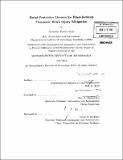Facial protective devices for blast-induced traumatic brain injury mitigation
Author(s)
Jason, Amanda Marie
DownloadFull printable version (8.696Mb)
Other Contributors
Massachusetts Institute of Technology. Dept. of Aeronautics and Astronautics.
Advisor
Raúl A. Radovitzky.
Terms of use
Metadata
Show full item recordAbstract
The purpose of the work in this thesis was to develop a finite element model of a helmet with various additional protective devices and to investigate how the personal protective equipment system affects the mechanical response of a human head subjected to a blast. Finite element models of the helmet with and without faceshields and goggles were developed from geometries of the Advanced Combat Helmet and the Enhanced Combat Helmet provided by the Natick Soldier Research, Development and Engineering Center. The helmet models were coupled with a simplified version of the existing DVBIC/MIT Full Head Model and subjected to a frontal 1 MPa blast for a duration of 1 ms using a computational framework suitable for simulating fluid-solid dynamic interactions. This framework was validated against experimental results of blasts carried out by the Carderock Division of the Naval Sea Systems Command Warfare Centers. The intracranial stress contours taken from these simulations suggest that the protective device systems alter the loading pattern experienced by the head as compared to the addition of a simple helmet. Pressure-time histories obtained from various points in the head indicate that the protective device systems reduce and broaden pressure peaks within the intracranial cavity, potentially mitigating the effects of blast-induced traumatic brain injury. Keywords: Blast Mitigation, Faceshield, Protective Devices, Blast Waves, Numerical Simulations, Traumatic Brain Injury.
Description
Thesis (S.M.)--Massachusetts Institute of Technology, Dept. of Aeronautics and Astronautics, 2010. Cataloged from PDF version of thesis. Includes bibliographical references (p. 75-77).
Date issued
2010Department
Massachusetts Institute of Technology. Department of Aeronautics and AstronauticsPublisher
Massachusetts Institute of Technology
Keywords
Aeronautics and Astronautics.